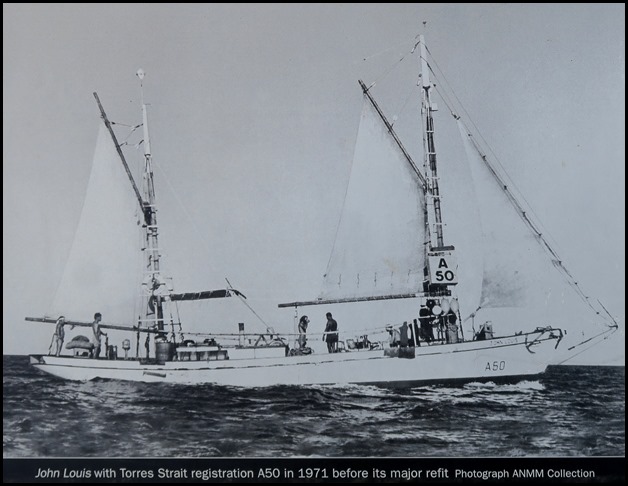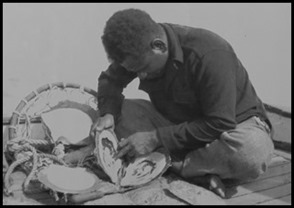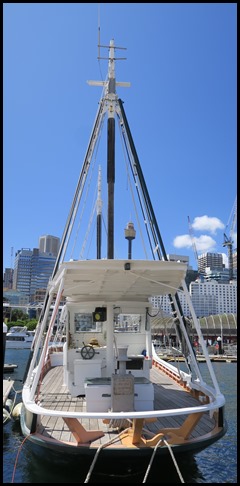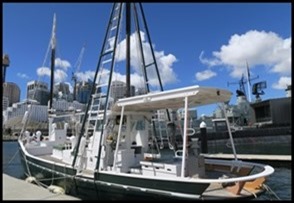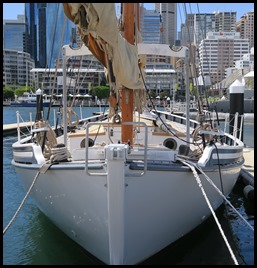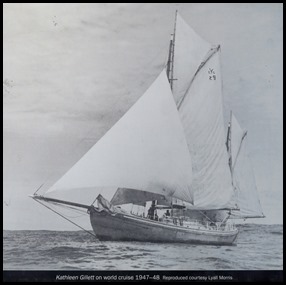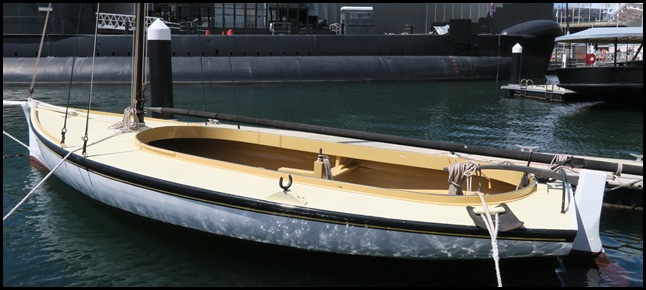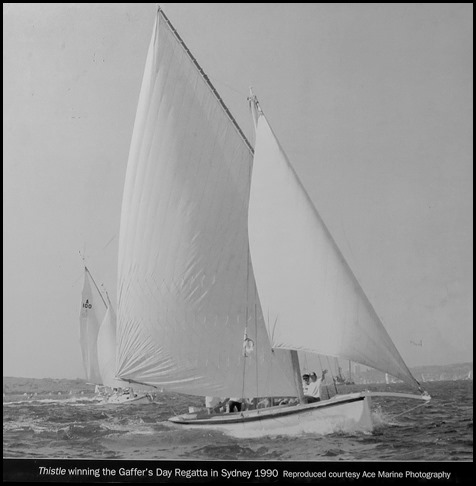Bevvy of Beauties

|
Bevvy of
Beauties  As we were walking toward the
National Maritime Museum we could see on our far left a girl called 83,
a very big girl and along the dock by the lighthouse - a bevvy of beauties. Girls to explore after going to the top
of the lighthouse.
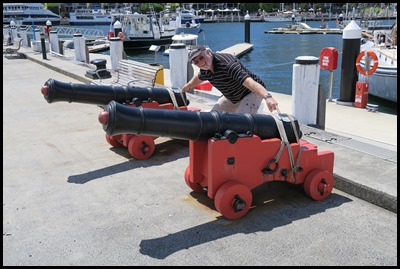 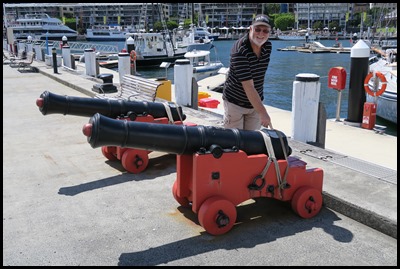 Lighthouse done, we walked past these
cannons and of course you-know-who’s trigger finger went all active.
 Our first ‘lady’ was called John Louis, yes, I will always call boats, ships in fact anything bigger than a Lilo (air-bed) a ‘she’. I was horrified when Lloyds of London began to refer to vessels as ‘it’. Huh. Not here............. We’ll stick to the old sailors saying "Like a woman, a ship is unpredictable" and when was the last time you saw a figurehead that wasn’t a bosomy lady........oooo enough of that, I may need a measure of grog...... Quite agree, madam, quite agree. John Louis was built in Broome in 1957 using local Western Australian timbers. She was one of the last traditional pearl shelling luggers built. The design of the Broome luggers evolved in response to the local environment, with the shallow draft and broad beam needed for the large tidal movements of the region. The crew, mainly Aboriginal, Torres Strait Islander, Malay or Japanese, slept and lived on the deck. Crew members worked tending the air hoses for the hard hat divers collecting pearl shell below. They cleaned the shell on deck. Pearl shell was a valuable material before the days of plastic. In the 1970’s the hard hat era ended. John Louis was modified for the growing cultured pearl industry and for the new form of diving called hookah, which used much lighter equipment. The foredeck was raised, forecastle accommodation built, the diesel engine replaced and an open wheelhouse and awnings were added. This is John Louis’ configuration today. Vital Statistics: Length 15.64 metres overall, width 4.39 metres, draught 1.73 metres, displacement 35.6 tonnes. Builder – Male and Co, Broome, Western Australia. Construction – Carvel, jarrah planking, karri frames, white gum decks, oregon spars. Engine – 6-cylinder Volvo Penta marine diesel 78 kW. Sail – auxiliary gaff ketch 58.27 square metres.
John
Louis - then and now. Kathleen Gillett is a famous cruising ketch built by
Charles Larson in Sydney for local artist Jack Earl and his wife Kathleen
Gillett in 1939. She is a double-edged design and based on original drawings by
Colin Archer, Norway’s best known 19th century naval architect. Archer drew upon
Scandinavian boat-building traditions dating back to the
Vikings. During
World War II the ketch was home to Jack and Kathleen. She was also used in New
South Wales coastal patrols. On the 26th of December 1945 Jack Earl (second left) and a crew of four competed
Kathleen Gillett in the first Sydney-Hobart Yacht Race, and in 1947 set
sail to circumnavigate the world. After Earl sold her in the 1950;s she was used in the island
trade, and also for crocodile hunting around Torres Strait and the Solomon
Islands. In 1967,
Kathleen Gillett again participated in the Sydney-Hobart Yacht Race.
Twenty years on, in 1987, the aged lady was restored in Guam, purchased and
restored by the Norwegian Government as a Bicentennial gift to the people of
Australia. Vital
Statistics: Length 13.18 metres on deck, 11.55 metres on the waterline. Width
4.45 metres, draught 2.09 metres. Displacement 23.44 tonnes. Ballast 3.37 tonnes
external, unknown internal amount but approximately 4 tonnes. Sail – gaff ketch,
area 101.01 square metres with topsail. Engine - Westerbeke 52.15 kW.
Restoration – Halvorsen Pty Ltd, Sydney. Thistle is a ‘couta boat’, a distinctive type of
commercial sailing vessel built for the barracouta fishery in Bass Strait off
the coast of Victoria. Crews, usually two, fished with poles or trolling lines
for couta and later, shark. The boats were sturdy and broad beamed, with a
centreboard that could be raised and lowered for good handling and drift
fishing. Their powerful rig, with tail sails and turned-down bowsprit, gave them
speed to outrun bad weather and for racing each other home to get the best price
for the catch. Thistle fished out of Port Fairy for most of her working
life. She is thought to have been built on the Maribyrnong River by a builder
named Jones in 1903. The couta fishery began to decline in the 1920’s. In the
1960’s, with an engine added, Thistle was used for towing, and in the
1970’s was converted to a houseboat. In 1990 she was restored to an early 1900’s
configuration. Vital
statistics: length 8.61 metres, width 3.07 metres, draught 2.44 metres,
displacement 5.78 tonnes. Sail – lug-rig sloop, area 55.43 square metres.
Construction – carvel planking, New Zealand kauri, stem keel and sternpost
Western Australian jarrah, frames blackwood, spars oregon, sails cotton.
Restored by Tim Phillips, Sorrento, Victoria.  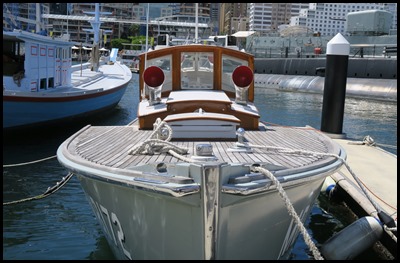 MB 172:
Motor Boat 172 was built in 1937 by the Royal Australian Navy as a District
Officer’s Boat at the Garden Island Dockyard, Sydney. She served initially in
Papua New Guinea through to the end of World War II and was then returned to
Sydney. MB 172 became a Senior Officer’s Boat, transporting officers and VIP’s
from ship to shore and around the harbour. Elegant timber launches such as this
were replaced by fibreglass and aluminium general purpose utility
boats.
When MB 172 decommissioned in the
late 1980’s, she was stored ashore for many years and stripped of all useable
equipment, apprentice shipwrights at the Australian Defence Industries rebuilt
the launch in their Ryde facility, she was later transferred to the National
Maritime Museum.
Vital Statistics.
Length 11.88 metres overall, Width 3.1 metres and draught 1.22 metres.
Displacement 10 tonnes. Construction: Carvel, spotted gum planking and frames,
teak cabin. Engine: 6-cylinder Volvo Penta TAMD 41 diesel, 125 kW.
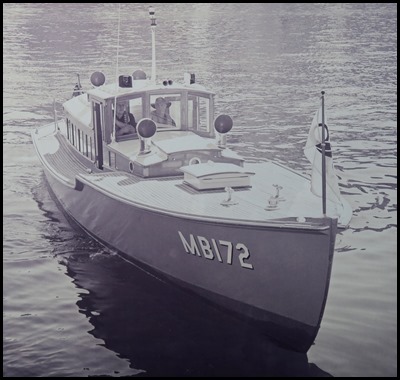 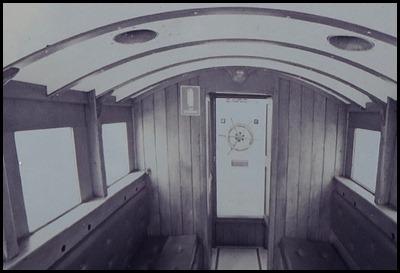 In action.
Elegant cabin.
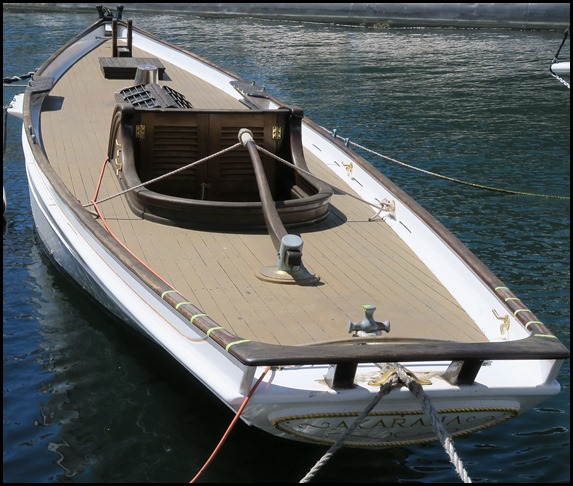 Akarana was built by New Zealander Robert Logan in
1888 to race in the centennial International Regatta on Hobson’s Bay, Victoria.
Akarana is the Māori name for Auckland. The yacht sailed in three races
against rivals from other Australian colonies with varying success.
In 1889 Logan brought Akarana to
Sydney to compete in the Anniversary Day Regatta on the 26th of January. She won
the open race on Sydney Harbour beating champion local yachts.
Logan sold Akarana in Sydney
where she sailed with the Royal Yacht Squadron. She remained in Sydney for the
next century and underwent many changes. In 1988, after a major restoration in
New Zealand, Akarana was welcomed back to Australia a hundred years
after she first arrived. She was a gift from New Zealand for the
Bicentenary.
A museum research project in 1998 led
to the reconfiguration of the keel. This has improved her stability under sail
and returned to Logan’s probable original specifications. Akarana is the oldest
lady in the National Maritime Collection.
Vital Statistics: Length 11.9 metres
on deck, 9.14 metres on the waterline. Width 2.03 metres, draught 2.5 metres.
Displacement 9.34 tonnes. Construction – Three layers of kauri planking on the
hull, oregon spars. 79.9 square metres of Egyptian cotton sails.
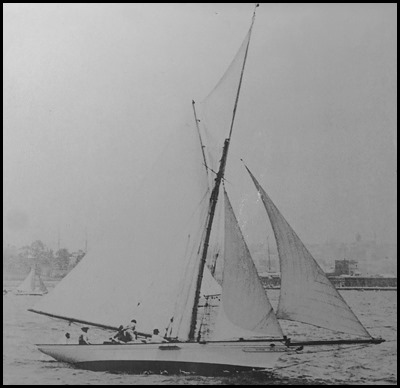 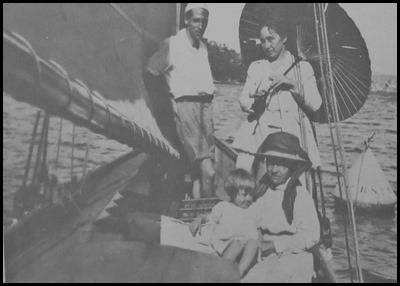 1889, Akarana sailing in the
National Regatta. Leigh family members aboard
in the 1920’s.
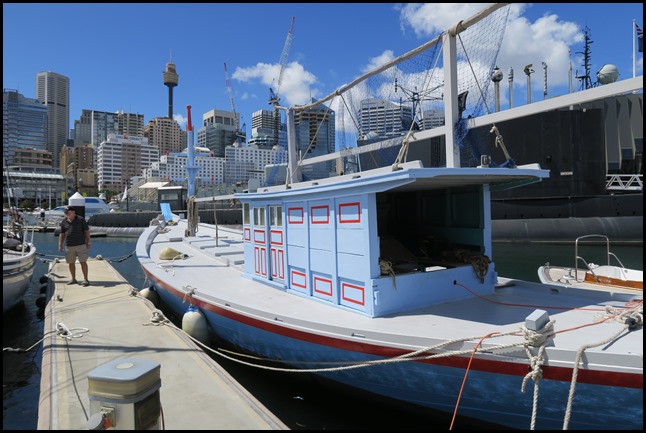 Tu
Do (which means ‘freedom) is a Vietnamese refugee boat built in 1975
by Tan Thanh Lu. Her passengers were part of the wave of people who fled South
Vietnam after the fall of Saigon on the 30th of April 1975. Tu Do was built as a dragnet fishing boat in a design
traditional to Phu Quoc Island, in the Gulf of Siam, south west of the
Vietnamese mainland. She was built to this design to avoid arousing suspicion of
the military authorities. Her Vietnamese registration number was VNKG1062ADC.
When she arrived in Darwin in November 1977 she had thirty one people on board,
allowing each person just three square metres of space. To Do had travelled
6,500 kilometres with only a map torn from a Vietnamese schoolbook and a
compass, guided by Tan Thanh Lu’s skill as a sailor. He later said
“Making the decision to escape is like going to war. You do it because you
think it’s necessary, but you never want to do it twice.”
Vital Statistics: length 18.25 metres
overall, width 4.5 metres, draught 1.26 metres. Displacement – 23.78 tonnes.
Engine – 3-cylinder Jinil diesel 33.56 kW. Construction – carvel, south east
Asian hardwoods, shorea planking over heritiera frames, fastened with wooden
treenails and steel dumps.
 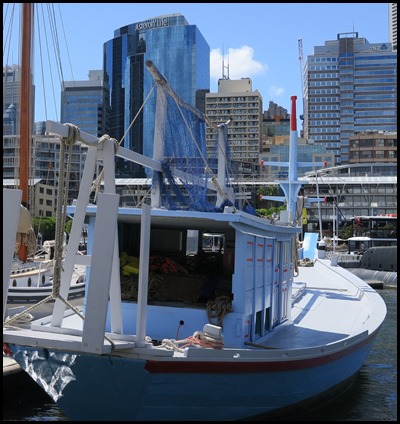 Tu
Do – an incredible story of an incredible lady.
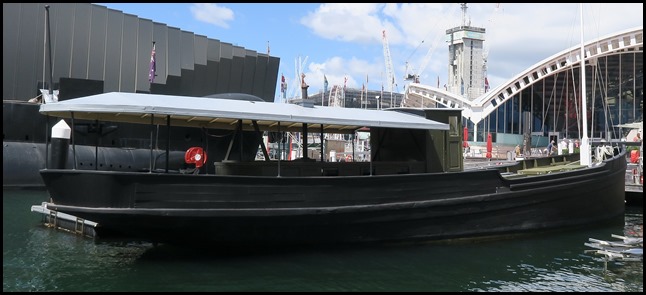 Krait was built as the Kofuku
Maru in 1934. Confiscated by the British during World War II she was
renamed Krait for a deadly Indian snake and was used for Operation
Jaywick – a surprise night raid on shipping in Singapore Harbour. Krait
sailed from Exmouth Gulf in Western Australia carrying a Z Special Unit team.
There were six commandoes and eight crew drawn from Australian and British Navy
and Army units. On the night of the 26th of September 1943, they sailed into
Japanese occupied waters masquerading as a local fishing vessel. The commandoes
paddled in folding canoes (folboats) to plant limpet mines, sinking two enemy
ships and damaging another five.
Krait
was rediscovered working in the Borneo timber trade and brought back to a
ceremonial welcome on Sydney Harbour in 1964. She was cared for by the Z Special
Unit Association and the Royal Volunteer Coastal Patrol. In 1985 she was
transferred to the Australian War Memorial and then moved here on display at the
National Maritime Museum. We would later see where she and ‘the boys’ did much
of their training for their daring mission in Refuge Bay up the coast in
Pittwater.
Vital Statistics: length 21.33
metres, width 3.35 metres, draught 1.5 metres. Displacement – 35.27 tonnes.
Construction – carved timber with teak planking. Engine – 6-cylinder Gardner
diesel 85 kW.
  Krait in training and some of
the brave boys.
 HMAS Advance: Twenty Attack class patrol boats were built
for the Royal Australian Navy between 1967 and 1969 for surveillance work around
the Australian coastline. HMAS Advance was built in 1968 and served out
of Darwin until 1980. In that time, the boat helped shadow a Russian fishing
ship suspected of spying, dispersed large numbers of illegal foreign fishing
boats, weathered Cyclone Tracy in 1974, assisted in hydrographic surveys of the
northwest coast, and became TV star when she was in the popular ABC series
Patrol Boat.
Her hull is steel and the
superstructure aluminium. Lightly armed for small-scale encounters,
Advance has her original 40 mm Bofors gun and two 12.7 mm machine guns
– used to put warning shots across the bow of a suspect vessel. She was
decommissioned in 1988.
Vital Statistics: Builder – Walkers
Ltd. of Maryborough, Queensland. Length 32.8 metres, width 6.1 metres, draught
2.2 metres. Displacement - 148.3 tonnes. Engines – Two Paxman V16 Ventura
turbo-charged diesels 2611 kW, twin screws. Compliment – 19.
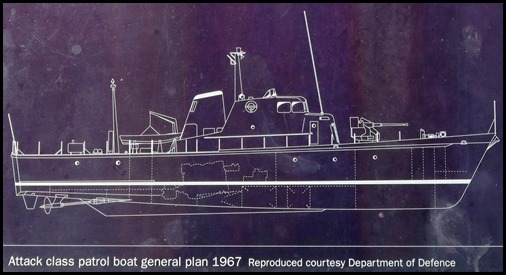 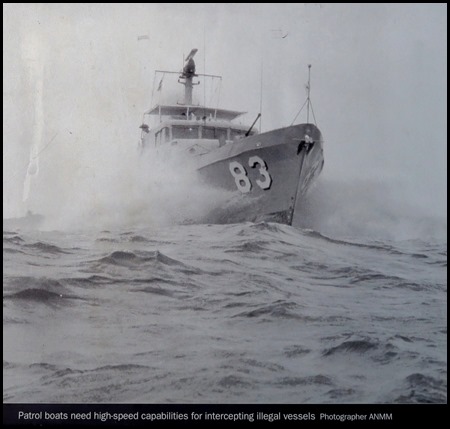 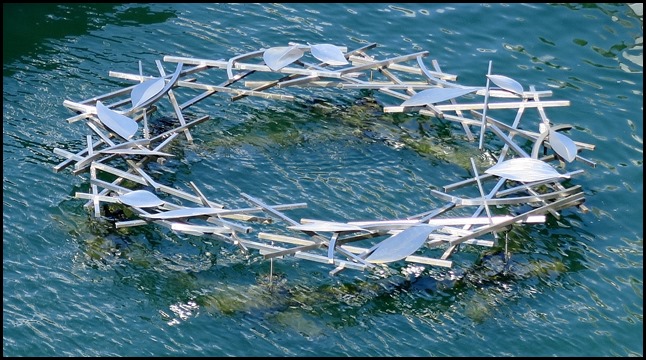 From the top of the lighthouse we had
seen this wreath glinting in the sunlight. This work
of art commemorates the loss, in the early months of World War I, of Australia’s
first submarine HMAS AE1 with its thirty five Australian and British
officers and crew. AE1 disappeared on the 14th of September 1914 while
patrolling German waters off Duke of York Island, present-day Papua New Guinea.
This was Australia’s first major loss of the war. So close to home, it had a
major impact on the public consciousness. The title of the work .....the ocean
bed their tomb’ is taken from a poem published in newspapers of the time by
South Australian Annie Almer. More than a hundred years later AE1’s
loss and location remain a mystery.
The artist Warren Langley talks about
the work: “A burial at sea is often accompanied by a floating wreath of
flowers. In 1914, early in the war, it is unlikely that the men of AE1 were
afforded that luxury. The concept for this work imagines an alternative, equally
beautiful wreath of floating twigs and branches from the waters off Papua New
Guinea. This work is about contemplation and reflection in both a literal and
metaphorical sense. In sunlight, the polished stainless steel structure shimmers
and reflects its image upon the water surface. At night a concealed light source
creates a complex optical illusion of reflections”.
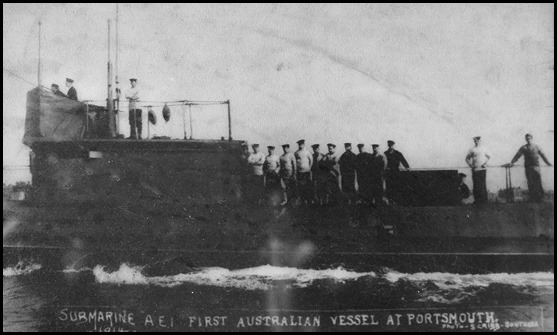 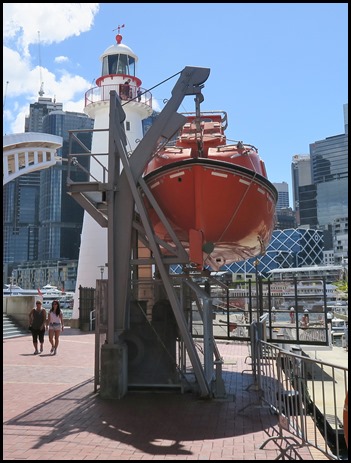 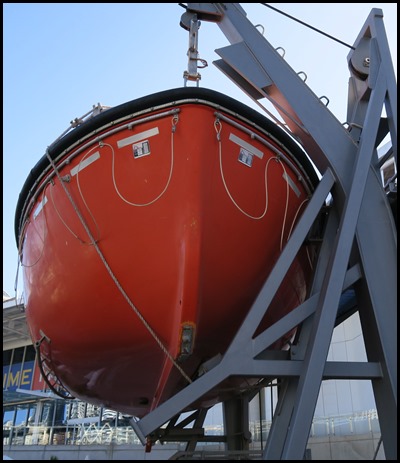 Our final lady was back to where we
started, a Harding MCH Lifeboat. This
totally enclosed lifeboat is the tanker version, designed for ships or offshore
installations where there is a risk of burning oil and dangerous gases. It may
be launched by a twenty metre vertical free fall, fully loaded, with all
occupants held by seat belts.
The occupants must wear seat belts at
all times to provide the ballast and centre of gravity needed to right the boat
if it capsizes in rough seas. The boat is designed to roll through 360 degrees
without affecting engine operation. Her hatches can be hermetically sealed.
Special features include a compressed-air passenger breathing system and a
diesel-driven seawater pump to spray the entire boat for cooling, allowing it to
pass through burning oil on the sea for a distance of one nautical mile. The
Harding lifeboat and davit were commissioned here at the Museum in 1993. The
lifeboat is owned and operated by the Sydney Institute of TAFE Marine Technology
Centre. She is regularly used to train seafarers in using survival craft, to
meet international requirements.
Vital Statistics: Capacity forty
people. Length 7.46 metres, Width 2.9 metres, draught 1.15 metres, weight 3.6
tonnes. She was built in 1984 by Harding AS, Rosendal, Norway. Construction:
Glass-reinforced fire retardant polyester (GRP) whole-moulded in one integral
unit. Machinery: 2 cylinder SABB diesel motor 212 kW (30 hp) 130 litre fuel
capacity.
 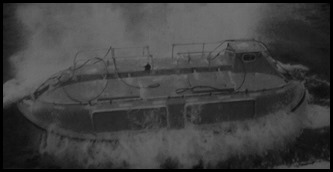 ALL IN ALL NICE TO SEE THESE
LADIES HAVE A PERMANENT HOME
SHAME WE COULDN’T GO ABOARD ANY OF
THEM |
